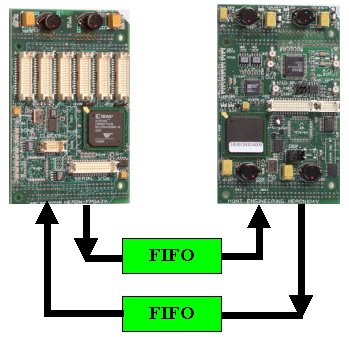Home>>HERON modular systems>>Combining multiple FPGAs
Combining Multiple FPGAs to Increase the Number of Gates
In a HERON system you can combine many modules to make different system configurations. These modules can be chosen from the C6000 DSP modules, the FPGA modules and the GDIO modules.
We often get asked if it is possible to have a larger FPGA on a particular module. Well, simply reading the data sheet of each module tells you what options are possible for each module, but what most people don't realise is that multiple FPGA modules can be used to increase the number of gates in your system.
 Each
FPGA in your system can be loaded with its own program, and the modules can use
the HERON FIFOs (using our Hardware Interface Layer
VHDL) to transfer data
between the FPGAs. This "connection" between the modules is a simple
FIFO interface so the modules don't need to process the data in
"lockstep"-- in fact it is not even necessary to use the same clock
frequency of you don't want to.
Each
FPGA in your system can be loaded with its own program, and the modules can use
the HERON FIFOs (using our Hardware Interface Layer
VHDL) to transfer data
between the FPGAs. This "connection" between the modules is a simple
FIFO interface so the modules don't need to process the data in
"lockstep"-- in fact it is not even necessary to use the same clock
frequency of you don't want to.
The connection can be bi-directional and, because of the design of HEART and the HERON module, the two connections run completely independently of each other. You can allocate bandwidth for each connection using HEART up to 400Mbytes/second, and the FPGA modules can sustain close to that transfer rate.
In this way you can extend the number of FPGA system gates beyond that currently available from a single chip, and you can combine FPGA only modules with FPGA and I/O modules to obtain the best blend of features from the range of modules available to you.
See HERON-FPGA modules for a list of what is currently available.